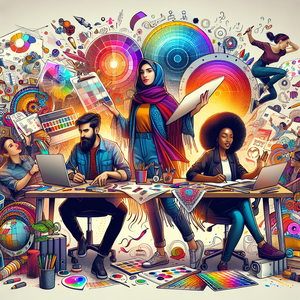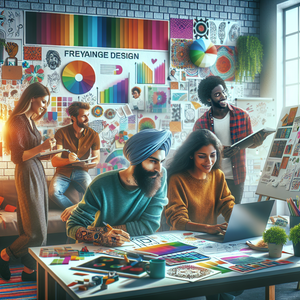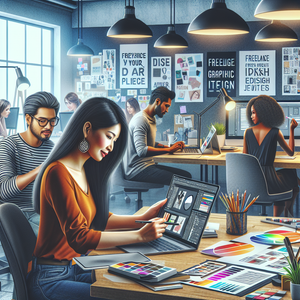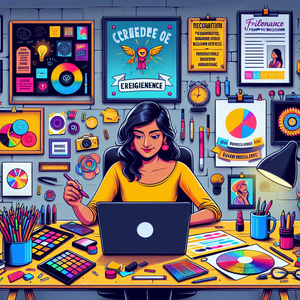
Unleashing Your Creative Potential: A Comprehensive Guide to Freelance Careers in Graphic Design and Art Direction
In an ever-evolving design landscape, freelance graphic designers and art directors play a pivotal role in shaping brand identities and storytelling through visual communication. This guide takes you through the exciting journey of becoming a freelance art director, emphasizing the importance of a solid educational foundation, a standout portfolio, and industry experience.
Job Summaries:
Freelance Graphic Designer:
- Freelance graphic designers are the visionaries behind visuals that communicate ideas effectively.
- They tackle a variety of projects, from logos to marketing materials.
- They closely collaborate with clients to bring their visions to life.
- Many prefer candidates with a degree in graphic design.
- Proficiency in industry-standard software like Adobe Creative Suite is essential.
- A robust portfolio is essential in attracting clients.
Art Director:
- Art directors orchestrate the visual elements of creative projects.
- They ensure the final output aligns with the client’s vision and brand identity.
- They work closely with designers, photographers, and other creatives.
- They deliver cohesive designs across various media, including advertising and digital platforms.
Junior Graphic Designer:
- Junior graphic designers, as entry-level professionals, assist senior designers and art directors in executing design projects.
- Their tasks may include creating layouts, supporting client presentations, and organizing design files.
Creative Director:
- Creative directors are responsible for the overarching creative vision of projects or organizations.
- They lead teams of designers, writers, and other creatives.
- They ensure concept development aligns with brand identity.
Graphic Design Intern:
- Interns in graphic design gain practical experience by working under the guidance of senior designers.
- They assist with tasks such as creating graphics, preparing presentations, and researching design trends.
Brand Designer:
- Brand designers focus on creating and maintaining a brand’s visual identity.
- They work on logos, typography, and color schemes.
- They collaborate closely with marketing teams.
- They ensure that branding materials effectively communicate the brand’s message.
Web Designer:
- Web designers are tasked with the aesthetics, layout, and usability of websites.
- They work with clients to develop visually appealing and user-friendly websites that reflect brand identity.
User Experience (UX) Designer:
- UX designers focus on optimizing user interactions with products or services
- Conducting research
- Developing user personas
- Designing wireframes
Motion Graphics Designer:
- Creating animated graphics and visual effects for various media is the role of motion graphics designers.
- Proficiency in software like After Effects and Cinema 4D is essential.
Illustrator:
- Illustrators craft original artwork for various applications.
- Applications include digital media and advertising.
- A unique style is essential for illustrators.
- Proficiency in diverse techniques is important.
- A strong portfolio is a key component for illustrators.
Advertising Designer:
- Advertising designers specialize in creating visual content for promotional materials.
- A degree in graphic design or advertising is often necessary, along with a portfolio demonstrating successful campaigns.
Print Designer:
- Print designers focus on creating visual materials for print media, such as brochures and posters.
- A degree in graphic design is typically required, along with proficiency in design software and print production processes.
Packaging Designer:
- Packaging designers are responsible for developing the visual design and structure of product packaging.
- A degree in graphic design or industrial design is often necessary.
Social Media Designer:
- Social media designers create engaging content tailored for various platforms.
- A background in graphic design or digital media is preferred.
- An understanding of social media trends is important.
Exhibition Designer:
- Exhibition designers craft layouts for trade shows and museums.
- Focusing on creating engaging displays.
- A degree in interior design or architecture is typically required.
Editorial Designer:
- Specializing in layouts for publications
- Editorial designers collaborate with writers
- Enhance storytelling through design
Environmental Graphic Designer:
- Environmental graphic designers create visual experiences within physical spaces.
- A degree in graphic design or environmental design is typically required.
Creative Strategist:
- Creative strategists develop marketing campaign strategies by analyzing trends and audience insights.
- A background in marketing or graphic design is preferred.
Visual Merchandiser:
- Visual merchandisers design displays in retail settings to enhance the shopping experience.
- A background in graphic design or marketing is often helpful.
Photography Art Director:
- Photography art directors oversee the visual aspects of photography projects
- Collaborating with creatives to produce compelling imagery.
The freelance landscape in graphic design and art direction offers a multitude of opportunities for creative professionals. For those interested in pursuing these paths, building a compelling portfolio, staying informed about industry trends, and engaging in effective networking are crucial steps for standing out in this competitive field.
Explore More Jobs

